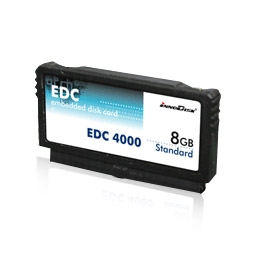Note: The difference between Single Channel and Dual Channel impact on the speed only, where the Dual Channel offer twice the read/write transfer speed performance compared to the single channel, since they are made of 2 chips that can be accessed simultaneously. This does not affect the compatibility and both models will be similarly recognised by the motherboard..
Embedded Disk Card 4000 (EDC4000) products provide high capacity solid-state
flash memory that electrically complies with the Personal Computer Memory Card
International Association ATA standard. InnoDisk Embedded Disk Card 4000
(EDC4000) is embedded solid-state data storage systems for industrial work
place. Embedded Disk Card 4000 (EDC4000) features an extremely light weight,
reliable, low-profile form factor. Embedded Disk Card 4000 (EDC4000) supports
advanced PIO (0-4), Multi Word DMA (0-2), Ultra DMA (0-4) transfer modes,
multi-sector transfers, and LBA addressing.
Embedded Disk Card 4000 (EDC4000) is available in capacities ranging from 32MB
to 8GB, making the upgrade path simple and fast. Available in 40-pin and 44-pin
horizontal connector packages, EDC4000 fits into any platform with an IDE
connector.
 |
Interface: 40pin or 44pin IDE/ATA
Capacity: 32MB~8GB
Data transfer rate:
Single: Read-
20MB/sec., Write- 10MB/sec.Dual: Read- 40MB/sec., Write- 20MB/sec.
Burst Speed Rate: 66.6MB/sec.
Low Power Consumption: 150mA
DC Input Voltage: +3.3V/+5V Single power supply
Dimension: 60.2/6.4/27.79 mm (W/T/H)
Power Mode: Auto stand-by mode |
 |
No additional device drivers are required. Embedded Disk Card 4000 (EDC4000) can be
configured as a boot device.
|
 |
The 40-pin EDC4000 version has a separate connector for the power supply, to
which a power supply cable can be connected. In addition, pin 20 can also be
used for power supply connections. Please refer to the pin description for
further details.
|
 |
Flash memory can be erased a limited number of times. This number is called the
erase cycle limit or write endurance limit and is defined by the flash array
vendor. The erase cycle limit applies to each individual erase block in the
flash device. EDC4000 uses a wear-leveling algorithm to ensure that consecutive
writes of a specific sector are not written
physically to the same page in the flash. This spreads flash media usage evenly
across all pages, thereby maximizing flash lifetime. |
 |
Operating Temperature Range
Standard Grade: 00C to +700C
Industrial Grade: -400C to +850C
Storage Temperature Range
Standard Grade: -550C to +950C
Industrial Grade: -550C to +950C
|
 |
Reliability Test Conditions
Vibration: 7 Hz to 2 KHz, 5 g, 3 axes
Mechanical Shock Duration: 10ms, 50 g, 3 axes
Product Condition MTBF (Hours): EDC4000 Telcordia SR-332 GB, 250C > 3,000,000
|
|
Capacity |
Cylinders |
Heads |
Sectors |
|
|
32MB |
500 |
8 |
16 |
|
|
64MB |
500 |
8 |
32 |
|
|
128MB |
500 |
16 |
32 |
|
|
256MB |
1000 |
16 |
32 |
|
|
512MB |
1015 |
16 |
63 |
|
|
1GB |
2031 |
16 |
63 |
|
|
2GB |
4063 |
16 |
63 |
|
|
4GB |
8146 |
16 |
63 |
|
|
8GB |
16000 |
16 |
63 |
|
|






